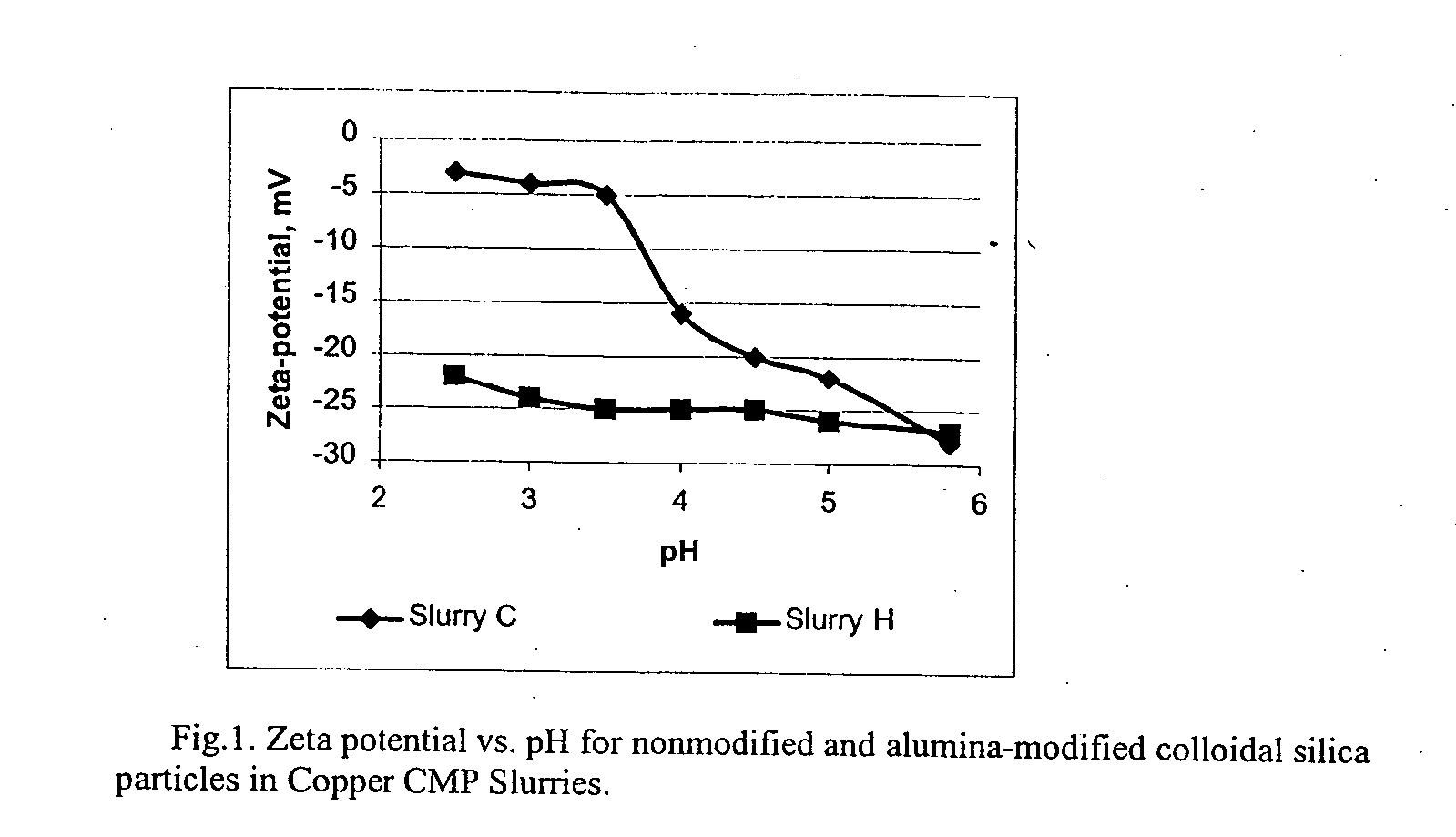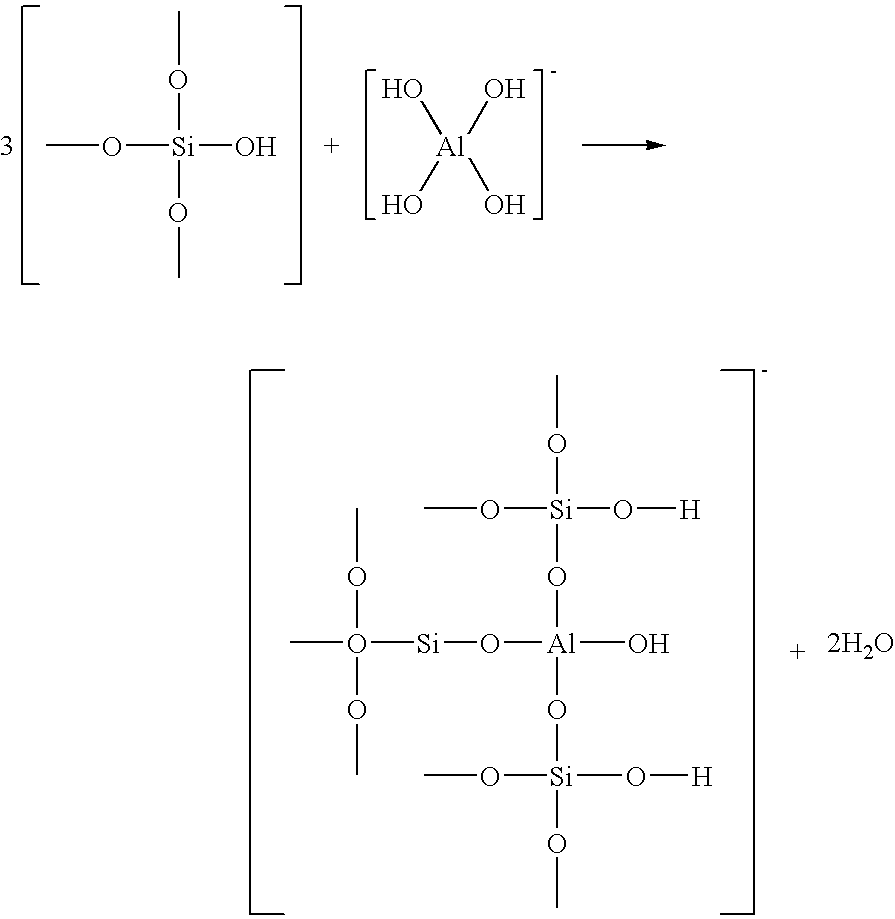Aqueous slurry containing metallate-modified silica particles
a technology of metallate and silica particles, which is applied in the direction of aqueous dispersions, lapping machines, other chemical processes, etc., can solve the problems of affecting device yield and performance, increasing the level of defects on the polished surface, and affecting the mechanical strength of low-k dielectric materials, etc., to achieve high negative surface charge, enhance the stability of the slurry composition, and high negative surface charge
- Summary
- Abstract
- Description
- Claims
- Application Information
AI Technical Summary
Benefits of technology
Problems solved by technology
Method used
Image
Examples
example 8
[0064] In Example 8, corresponding slurry H, has been prepared by adding 1.74 g BTA (from Sigma-Aldrich) and 32 g glycine (Sigma-Aldrich) into 3,120 g deionized H2O. A diluted solution of 7 weight percent H3PO4 was employed to adjust the pH to about 3.2. Thereafter, 106.6 g of 30 weight percent water dispersion of aluminate-modified colloidal silica with particle size Zav equal to 77 nm was added to the solution while mixing. The resulting content of colloidal silicon dioxide was 1 weight percent. The slurry was then mixed for 0.5 hours.
[0065] Therefore, the only difference between Slurry C (i.e. Comparative Example 3) and the one of Slurry H is the type of colloidal silica particles employed. The Zeta potential versus the pH was measured for both slurries and presented in FIG. 1.
[0066] As shown from this data, for unmodified particles negative surface charge rapidly decreases at pH below 4.0, indicating a destabilization of the slurry. Aluminate-modified particles, on the other h...
example 9
[0068] To further explore the impact of aluminate modification on colloidal silica stability in acidic slurries, several compositions with a varying particle size (i.e., Zav ranging for 40 to 90 nm) were prepared. These slurries were compared side-by-side with a slurry having the same exact composition, but for the fact that the colloidal silica is non-modified. The data obtained is depicted in FIG. 2.
[0069] As the data indicates, the slurries containing the modified aluminate silica particles of different particle sizes have been found to be more stable (i.e., measured by Zeta potential) in an acidic environment (i.e., pH of 4.0 or less), as compared to the non-modified composition.
examples 10-15
[0070] Slurries with various amounts of aluminate-modified silicon dioxide abrasive particles were prepared by adding 1.74 g BTA and 32 g glycine into 3,120 g deionized H2O. The pH of the slurries were adjusted to pH=3.2 by adding 7 weight percent of H3PO4. Thereafter, 30 weight percent water dispersion of aluminate-modified colloidal silica (having particle size Zaz of 48 nm) was added under permanent mixing, so that the resulting content of SiO2 was equal to 0, 0.5, 1.0, 2.0, 3.0 and 5.0 weight percent in Examples 10-15 (corresponding to Slurries I-N, respectively and listed in Table 2, below).
[0071] Each of the slurries were mixed for 0.5 hours. Thereafter, the slurries were mixed with 20 ml of H2O2 (as 34 weight percent water solution), so that the final content of H2O2 was equal to 2 volume percent. The slurries were then used to perform the above-described polishing test. The removal rate of blanket copper film for each of these slurries is reported in Table 2.
TABLE 2Remova...
PUM
| Property | Measurement | Unit |
|---|---|---|
| size | aaaaa | aaaaa |
| pH | aaaaa | aaaaa |
| pH | aaaaa | aaaaa |
Abstract
Description
Claims
Application Information
 Login to View More
Login to View More - R&D
- Intellectual Property
- Life Sciences
- Materials
- Tech Scout
- Unparalleled Data Quality
- Higher Quality Content
- 60% Fewer Hallucinations
Browse by: Latest US Patents, China's latest patents, Technical Efficacy Thesaurus, Application Domain, Technology Topic, Popular Technical Reports.
© 2025 PatSnap. All rights reserved.Legal|Privacy policy|Modern Slavery Act Transparency Statement|Sitemap|About US| Contact US: help@patsnap.com



